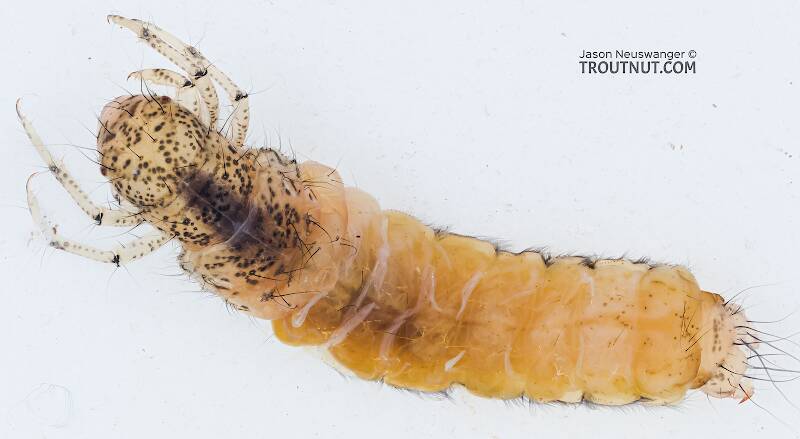
Hex Mayflies
Hexagenia limbata
The famous nocturnal Hex hatch of the Midwest (and a few other lucky locations) stirs to the surface mythically large brown trout that only touch streamers for the rest of the year.
Featured on the forum

This is a striking caddis larva with an interesting color pattern on the head. Here are some characteristics I was able to see under the microscope, but could not easily expose for a picture:
- The prosternal horn is present.
- The mandible is clearly toothed, not formed into a uniform scraper blade.
- The seems to be only 2 major setae on the ventral edge of the hind femur.
- Chloride epithelia seem to be absent from the dorsal side of any abdominal segments.
Based on these characteristics and the ones more easily visible from the pictures, this seems to be Grammotaulius. The key's description of the case is spot-on: "Case cylindrical, made of longitudinally arranged sedge or similar leaves," as is the description of the markings on the head, "Dorsum of head light brownish yellow with numerous discrete, small, dark spots." The spot pattern on the head is a very good match to figure 19.312 of Merritt R.W., Cummins, K.W., and Berg, M.B. (2019). The species ID is based on Grammotaulius betteni being the only species of this genus known in Washington state.
- The prosternal horn is present.
- The mandible is clearly toothed, not formed into a uniform scraper blade.
- The seems to be only 2 major setae on the ventral edge of the hind femur.
- Chloride epithelia seem to be absent from the dorsal side of any abdominal segments.
Based on these characteristics and the ones more easily visible from the pictures, this seems to be Grammotaulius. The key's description of the case is spot-on: "Case cylindrical, made of longitudinally arranged sedge or similar leaves," as is the description of the markings on the head, "Dorsum of head light brownish yellow with numerous discrete, small, dark spots." The spot pattern on the head is a very good match to figure 19.312 of Merritt R.W., Cummins, K.W., and Berg, M.B. (2019). The species ID is based on Grammotaulius betteni being the only species of this genus known in Washington state.

Troutnut is a project started in 2003 by salmonid ecologist Jason "Troutnut" Neuswanger to help anglers and
fly tyers unabashedly embrace the entomological side of the sport. Learn more about Troutnut or
support the project for an enhanced experience here.
NEMatt on Aug 16, 2014August 16th, 2014, 12:24 am EDT
Been fly fishing a couple years now (novice still) and I'm having trouble setting the hook while dead drifting nymphs. I typically use either a single nymph or a dry dropper setup. Most of the time with either a weight or strike indicator or both. Tried everything.
In order to get a drag free drift, I usually throw a few mends in the line. My question is, with this slack created by the mends, how am I supposed to set the hook when I see the indicator twitch or disappear?
I high stick when I can to keep the line out of the water while still having control of the line, but when I have to reach across the stream, I can't seem to get it right.
Any advice would be appreciated.
In order to get a drag free drift, I usually throw a few mends in the line. My question is, with this slack created by the mends, how am I supposed to set the hook when I see the indicator twitch or disappear?
I high stick when I can to keep the line out of the water while still having control of the line, but when I have to reach across the stream, I can't seem to get it right.
Any advice would be appreciated.
Catskilljon on Aug 16, 2014August 16th, 2014, 4:02 pm EDT
how am I supposed to set the hook when I see the indicator twitch or disappear?
What works for me is a sharp lifting of the rod :)
Seriously, I don't quite understand your conundrum. Even with slack in the line unless your fishing a 4ft fly rod, your can get 10ft of slack out of the water by simply lifting the rod at a 60* angle. Having mends/slack/curves in the line is something everyone deals with. The only time your totally in contact with no slack is when your tight line high sticking nymphs close in.
Are you missing fish? Just because your line twitches/ indicator goes under doesn't always mean there is a trout on the other end. You should be prepared for it when it does, but the bottom does similar things to your indicator.
Are your hooks good and sharp? I recently switched to the competition barbless hooks, and they are so sharp and well formed the fish basically hook themselves.
Hope this helps, CJ
NEMatt on Aug 16, 2014August 16th, 2014, 10:19 pm EDT
I can usually tell if it's the bottom. Can't guarantee other twitches are fish but I'd like to think so, Ha! Probably not given that I've been tying all my own flies. Butchering would be a better word!
I've been mashing down the barbs on all my hooks before I tie them. Haven't sharpened them though. Do you think they need a quick sharpening right out of the package?
Thanks for your response.
I've been mashing down the barbs on all my hooks before I tie them. Haven't sharpened them though. Do you think they need a quick sharpening right out of the package?
Thanks for your response.
Catskilljon on Aug 17, 2014August 17th, 2014, 3:24 pm EDT
Can't guarantee other twitches are fish but I'd like to think so, Ha!
Don't I know it, I feel the same way...always hopeful!
I've been mashing down the barbs on all my hooks before I tie them. Haven't sharpened them though. Do you think they need a quick sharpening right out of the package?
That depends on the brand. Quality hooks are usually ready to fish right out of the box, but even then occasional bumps on the bottom can sometimes take enough off to make them less than "new sharp". If your tying your own, I would suggest for you to just try a pack of the hanak or dohiku hooks, to see what your missing. You cannot believe how sharp and pointy they are till you feel one. Its been a game changer for me. Before I found those, I switched to dry fly hooks for my nymphs, as the finer wire penetrated better than the 1X and 2X heavy wire nymph hooks.
There are a whole lot of variables to this game, and eliminating the ones that are slowing progress is a time consuming but worthwhile effort. Keep at it man, it comes slowly, but its a good feeling everytime you move up a rung on the ladder!
Good luck and let us know. CJ
PaulRoberts on Aug 17, 2014August 17th, 2014, 5:12 pm EDT
I do understand your conundrum. It's the bane of every nymph fisher: detection.
I do not fish a nymph "dead drift" in the dry fly sense -except in three ways:
-when using a very short (less than 12") dropper, usually off a dry fly, yarn, or tiny stick-on foam piece.
-Using the "Right Angle" rig which allows for a vertical presentation on slow water.
-Sometimes on sighted fish I can see really well.
Otherwise, I have to keep tension between my fly and indicator (either a visual one or by feel via tightline), otherwise, as you know, there is no detection. The trick to getting a natural drift is to maintain controlled drag. I do that by identifying and fishing laminar flow -even really small, or "hidden", lanes. Nymph fishing is all about understanding and reading current.
The technique/rigging part I'll describe this way:
The more turbulence, the colder (more viscous) the water, and the deeper, the more difficult maintaining control becomes. In those conditions I decrease tippet diameter, inc weight, and go up in indicator size (or forgo altogether and go by feel) to slice water like a knife through butter -the tippet should be strung tight between weight and indicator -otherwise there is no detection. Water is thick gelatinous stuff, and you do not have detection if you are fishing slack line -unless you can actually see the takes.
As to detecting all takes and samplings you'll get from trout -you won't.
Hope this clears things up a bit and gets you started.
I do not fish a nymph "dead drift" in the dry fly sense -except in three ways:
-when using a very short (less than 12") dropper, usually off a dry fly, yarn, or tiny stick-on foam piece.
-Using the "Right Angle" rig which allows for a vertical presentation on slow water.
-Sometimes on sighted fish I can see really well.
Otherwise, I have to keep tension between my fly and indicator (either a visual one or by feel via tightline), otherwise, as you know, there is no detection. The trick to getting a natural drift is to maintain controlled drag. I do that by identifying and fishing laminar flow -even really small, or "hidden", lanes. Nymph fishing is all about understanding and reading current.
The technique/rigging part I'll describe this way:
The more turbulence, the colder (more viscous) the water, and the deeper, the more difficult maintaining control becomes. In those conditions I decrease tippet diameter, inc weight, and go up in indicator size (or forgo altogether and go by feel) to slice water like a knife through butter -the tippet should be strung tight between weight and indicator -otherwise there is no detection. Water is thick gelatinous stuff, and you do not have detection if you are fishing slack line -unless you can actually see the takes.
As to detecting all takes and samplings you'll get from trout -you won't.
Hope this clears things up a bit and gets you started.
Quick Reply
Related Discussions
Topic
Replies
Last Reply


